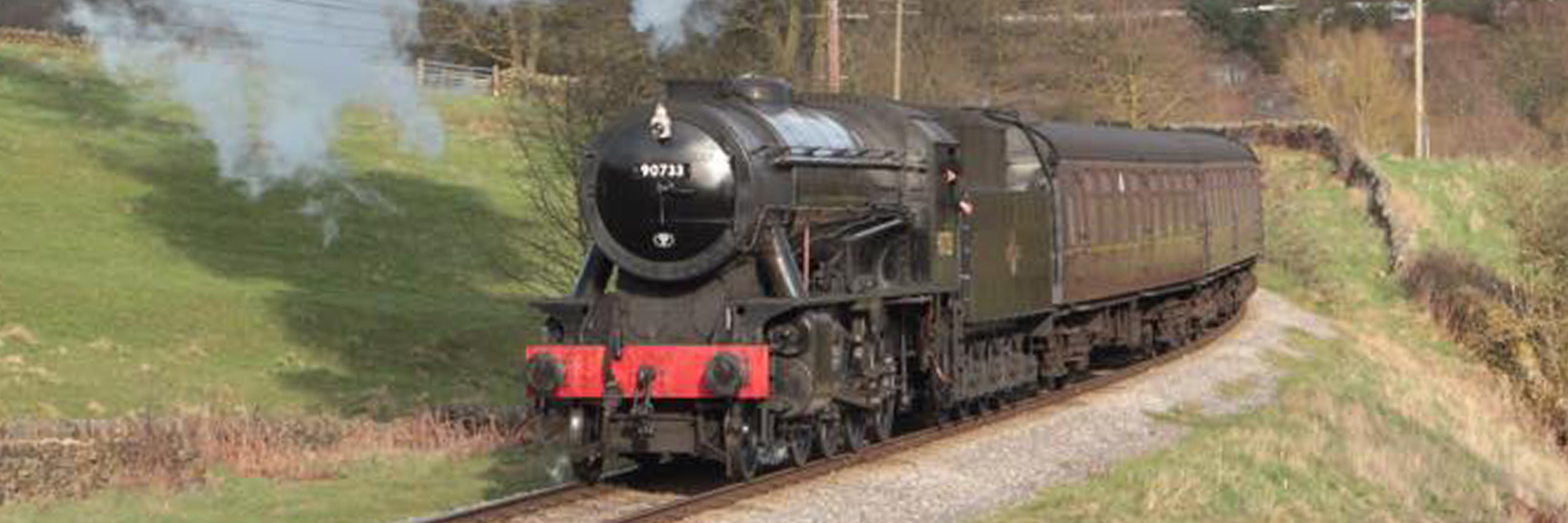A wartime soldier in from the cold
Built to a wartime design and, like 5820, for use in the war effort, WD 90733 is a unique engine, being the last of its kind. This locomotive was an integral part of the operating fleet until December 2018 when it was withdrawn for its 10-year overhaul to take place. Having survived hostilities in Europe, our ‘WD’ was initially used on the Dutch railways and then moved to Sweden but was ‘frozen out’ in 1958, only to be brought to warmer climes in the winter of 1973. 90733 is a survivor!
Data File
Built: 1945 Vulcan, Newton-le-Willows
Boiler Pressure: 225 psi
Tractive Effort: 34,215 lbf
Weight 70.25 tons engine; 56 tons tender
Valve Gear: Walschaerts
Cylinders: 19″x28″ Outside
Numbers carried during working career: Vulcan Foundry 5200, War Department 79257, Netherlands Railway 4464, Swedish State Railway 1931, KWVR 90733
A short career on European national networks
This class of locomotive entered service early in 1943 and was designed by R.A. Riddles. Riddles had been part of the design team for the LMS Stanier 8F. Using this experience and looking at the newly arrived US Transportation Corp 2-8-0 (see 5820), he developed the WD Austerity 2-8-0 as the new standard heavy freight engine to aid the war effort. The major differences between this design and the LMS Stanier 8F are an increase in cylinder diameter, the use of a round-topped firebox, a parallel boiler and an 8 wheeled tender. The intention of the “WD” was to enable it to be built by any one of several manufacturers and to use only materials which were readily available in wartime. The wheels are of similar design to the Bullied Pacifics of the Southern Railway in having no reciprocating weights.
Built-in January 1945 by The Vulcan Foundry Ltd., Newton-le-Willows, for the war effort, the locomotive was shipped to the continent on completion to aid troop and supplies movement across Europe. At the cessation of hostilities, it was sold to the Netherlands State Railways where it became their 4300 class no. 4464. In 1953 it was re-sold to the Swedish State Railways and given the classification G11.
In Sweden, now numbered 1931, it was heavily modified to enable it to work in the Arctic Circle and entered traffic in 1954. This included the provision of a fully enclosed cab, the installation of standard Swedish boiler fittings and the addition of facilities for steam heating coaching stock. Apart from the enclosed cab the most noticeable difference with others of this class was the shortening of the tender from 8 wheels to 6. This was to enable the locomotive to fit on the smaller turntables available in the northern part of the Swedish network.
It was not operational for long, being withdrawn in October 1956. Some minor restoration work took place prior to it being taken to an isolated forest clearing in northern Sweden in 1958 where it was stored undercover as part of a strategic reserve until the end of 1972.
Out of the deep freeze and into the fridge
In September 1972, 1931 was purchased by a group of KWVR volunteers, leaving the Arctic winter in Sweden behind arriving back in a ‘warmer’ UK winter at Hull on the 12th January 1973 and offloaded at Ingrow the following day. Only a minimal amount of work was necessary to put the locomotive back into service, but in 1976 it was withdrawn due to its general run-down condition.
A heavy repair was started in 1993 to rebuild it to as-built form. All the Swedish alterations and fittings were removed and, with the purchase of the chassis of an original 8 wheel tender from Holland and construction of a new tender tank, an original War Department 8F 2-8-0 took shape. Restoration complete, the locomotive finally returned to Haworth on Monday 16th April 2007 and following a period of testing and running-in, it officially re-entered traffic on Monday 23rd July 2007, now numbered in the BR series as 90733, the next number in the BR sequence for repatriated engines on British Railways, which ran 90000 – 90732.
Restoration complete, the locomotive finally returned to Haworth on Monday 16th April 2007 and following a period of testing and running-in, it officially re-entered traffic on Monday 23rd July 2007, now numbered in the BR series as 90733, the next number in the BR sequence which ran 90000 – 90732. The engine has been restored to its original British outline and has proved to be more than capable of
Our ‘WD’ is unique in preservation, being of 2-8-0 configuration with all other preserved examples of the WD being the larger 2-10-0. This is quite remarkable considering that there were over 700 examples of everyday use with BR after the war. Every single one went to scrap! This loco, of course, never served in Britain until its time with the KWVR, so 90733 was selected as its number as this would have been the next available in the British Railways stock list, had it returned from overseas service at the end of its war-time exploits abroad.
With its 10-year boiler certificate expiring in 2017, 90733 was granted an extension into 2018. Unfortunately, whilst on Santa Steam Special duties in December 2017, cracks were discovered in the boiler tubes and the Railway had to reluctantly withdraw the locomotive from traffic with its latest overhaul starting in early 2019.
